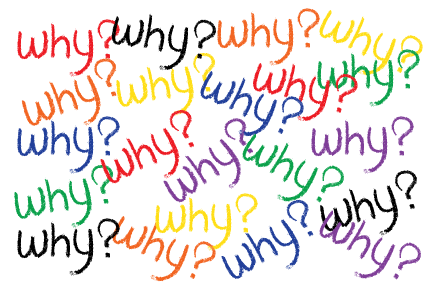DIAGNOSIS – Ask WHAT not WHY
The first step in problem-solving.
Unless you can diagnose the problem it is impossible to fix the problem. Anyone who has an undiagnosed problem whether it be medical, auto, people, being lost, etc, faces frustration, confusion, and often anger.
It is in our human nature to want to know the WHY.
Why did you do it?
Why didn’t somebody tell me?
Why wasn’t it stopped sooner?

Why, why, why, why? One why can create a thousand more why’s.
We three Crowell boys grew up with an angry father. Brother Mike was a master at milking the WHY question. To this day I break out in laughter reviving this WHY encounter between Mike and dad.
Dad: “Why did you do this to your hair?”
Mike: “Who, me?” (Bewildered facial expression was classic.
Dad: “Who the ______ do you think I’m talking about, Mike?”
Mike: “Huh?”
Now, father elevates voice either out of anger or thinking Mike could not hear him!
Dad: “Why did you get your hair cut like that?!!!!!”
Mike: “I don’t know.”
Dad: “Why don’t you know?”
Blank look answer. Now Mike stands in silent stupefaction.
Dad: “Why don’t you answer?”
Mike: “I don’t know.”
Watch the news. The focus is WHY?
Change the narrative to WHAT. WHAT is a superior to diagnostic discovery than the WHY.
Basic fundamentals to help develop the skill of being able to diagnose any problem:
- Recognize that it is easier to recognize another person’s problems but be blind to your own.
- Recognize nearly every person has an opinion. Ask a minimum number of counselors. They must have PTR & WOBI. (Proven track record; worthy of being imitated).
- Recognize when anyone says, “If I were in your shoes this is what I would do. Fact is, if they were in your shoes they would do exactly what you would do.
- If you have not had the exact same experience never say, “I know how you feel.” “I understand what you’re going through.” Fact: you have no idea what they’re going through.
Four starter steps to developing the ability to diagnose a problem:
- Seek the counsel of a wise person who has a PTR & WOBI.
- Ask pertinent questions. Let people tell their story.
- Discover their hopes, goals, and dreams.
- Identify the presenting problem. Know it is seldom the real problem. What is causing the present problem?
Diagnosis is not an easy skill to master. Commitment to learn. Leading with kindness and genuine care are vital skills to have in your LIFEBALL skills tool box.








